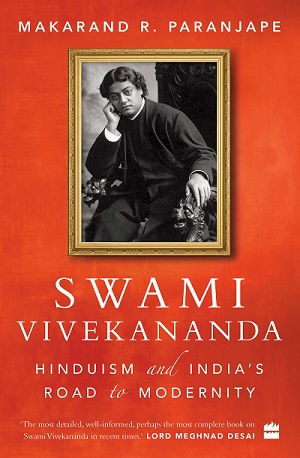Swami Vivekananda is an enigma for me. I have not read him or about him, not even during my school days. I met him occasionally during my travels when I saw many places in India commemorating his visit. The most famous is of course the Vivekananda Rock at Kanyakumari where he meditated on the rock in the sea, which changed the direction of his life. His famous speech in Chicago is what most of us know of.
 So, when this book came to me for review, I was keen to read it. I have interacted with the author a few times. Though it has been formal meetings only at common events. I know he has written many books, but this is the first one I am reading. Strangely, I could not locate any reviews of the book anywhere on the internet, apart from some one-liners on Amazon.
So, when this book came to me for review, I was keen to read it. I have interacted with the author a few times. Though it has been formal meetings only at common events. I know he has written many books, but this is the first one I am reading. Strangely, I could not locate any reviews of the book anywhere on the internet, apart from some one-liners on Amazon.
Swami Vivekananda: Hinduism and India’s Road to Modernity by Makarand Paranjape on Amazon
I learned a few things about Swami Vivekananda from this book like he smoked and consumed alcohol. But he maintained his vows of staying away from Kama and Kanchana. He took multiple names before settling for Vivekananda and the fact that he spent most of his time in the west after his famous Chicago address. I was amused to learn that he was a contracted speaker in America with a company. Well, these are tidbits you pick up from the book.
The book gives you a brief snapshot of Vivekananda’s life, his works, his speeches, and the ideas that he tried to propagate by traveling and delivering lectures tirelessly across the world. It gives you a glimpse of his childhood that includes his brush with Brahmo Samaj. Then of course his association with his Guru – Ramakrishna. I was curious about their Guru-Shishya relationship as on the face of it, they sound very different personalities. There is not much in the book, maybe not much in the chronicles.
Read More – Complete works of Swami Vivekananda at Amazon
Introduction of Hinduism to Western World
Based purely on this book, it seems Swami Vivekananda’s greatest contribution is taking Hinduism to the west. He is probably the first of the spiritual personalities to travel to America and Europe. He conducted extensive talks on Hinduism talking about Raj Yoga, Karma Yoga, Bhakti Yog, and Jnana Yog. All these talks have been converted into books. He realized the need to set up an organization. He did create the Ramakrishna Mission. The name of the organization is interesting. It’s called a mission instead of an ashram or a Sansthan or any other word used for organizations.
The book has a compilation of select poems of Vivekananda. I was pleasantly surprised to see that he wrote some poems in Sanskrit. Rest of the poems, I hope to read them in original someday. What is important is that he did all that he did in the mere last nine years of his life.
Read More – Sri Aurobindo And India’s Rebirth Edited By Michel Danino
There are some places where I disagree with the author. Like he tends to believe that the Vivekananda never meditated on the rock that is now named after him at Kanyakumari. He is right that the Kanyakumari temple is at the shore and not on the rock. But he misses the fact that the feet of the Devi are indeed on the rock.
I do not think the author understands quantum physics, so he thinks science is exact and spirituality. Quantum or particle physics is all about probability and it can never be exact. He is probably rooted in classical physics which was prevalent at the time of Vivekananda. At one place he says Islamists were not inimical towards Hindus – during the time of Ramakrishna while comparing him with his disciple.
Read More – Kabir by Hazari Prasad Dwivedi
Nobel Prize
At one place he mentions that talks about no Indian scientists have won Nobel Prize post-independence. I would like to ask him why is Nobel Prize important? Is it not a colonial construct that repeatedly honors its own? The last chapter is lost in academic discourse on ‘What is modernity?’ quoting different scholars and sources. There is little Vivekananda there.
Overall, I did get a glimpse of Vivekananda. It tries to give a balanced view of Vivekananda as seen from outside India and from India. I need to read some if not all of Vivekananda’s works to make my own opinion. This book leaves a lot of gaps. Modernity that is its main point of exploration is presented more from the point of others and not from the point of view of its protagonist.
Read More – Adi Shankaracharya: Hinduism’s Greatest Thinker by Pavan K Varma
I feel this review is a bit confused, but I guess that is my state after reading this book. It has a great beginning but halfway through it loses steam and keeps repeating itself, with a lot more jargon. Language oscillates between being conversational to being academic.
Take your call.









in the midst of your confusion u have rightly pinted out the western bias of the nobel prizes
in the midst of your confusion u have rightly pointed out the western bias of the nobel prizes
Swamiji never drank wine. This is utter lie.
Please tell this to the author of the book.